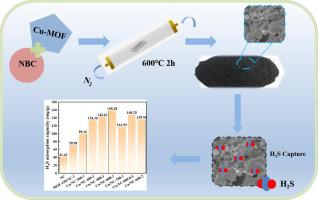Our official English website, www.x-mol.net, welcomes your feedback! (Note: you will need to create a separate account there.)
Cu-MOF-derived Cu nanoparticles decorated porous N-doped biochar for low-temperature H2S desulfurization
Fuel ( IF 7.4 ) Pub Date : 2024-04-13 , DOI: 10.1016/j.fuel.2024.131682 Lingwen Song , Yi Yuan , Yuan Wang , Tian C. Zhang , Ge He , Shaojun Yuan
Fuel ( IF 7.4 ) Pub Date : 2024-04-13 , DOI: 10.1016/j.fuel.2024.131682 Lingwen Song , Yi Yuan , Yuan Wang , Tian C. Zhang , Ge He , Shaojun Yuan

|
Hydrogen sulfide (HS) is a highly toxic and corrosive gas that poses significant risks to human health and the environment. Therefore, the development of an adsorbent capable of efficiently purifying HS at room temperature remains a challenging task. In this study, a novel composite adsorbent with a specific surface area of 434 m·g was fabricated by modifying porous N-doped biochar with Cu nanoparticles (Cu/NBC) derived from Cu-MOFs for low-temperature desulfurization of HS. The effect of pyrolysis temperature and the doping ratio of Cu-MOFs to biochar on the desulfurization performance of HS for the as-prepared Cu/NBC was comprehensively investigated. Experimental results indicated that the desulfurization capability of the optimized Cu/NBC-600-1 adsorbent (synthesized at a pyrolysis temperature of 600 °C and a doping ratio of 1:1) was significantly affected by the desulfurization conditions, and the optimal conditions were determined to be at 25 °C, with 20 % oxygen content and 70 % relative humidity. Under the optimized conditions, the Cu/NBC-600-1 adsorbent exhibited a high HS removal capacity of 158.28 mg·g, which was about 3.8 times higher than that of the pristine N-doped biochar. The desulfurization mechanism of the Cu/NBC composite was demonstrated to involve reactive adsorption and catalytic oxidation, resulting in the formation of elemental sulfur and copper sulfides as the main products. This study not only provides a promising approach to modify porous biochar with MOF derivatives, but also offers an effective strategy to remove low concentration HS at room temperature.
中文翻译:

Cu-MOF衍生的Cu纳米颗粒装饰多孔氮掺杂生物炭用于低温H2S脱硫
硫化氢(HS)是一种剧毒、腐蚀性气体,对人类健康和环境构成重大风险。因此,开发能够在室温下有效净化 H2S 的吸附剂仍然是一项具有挑战性的任务。在这项研究中,通过用Cu-MOFs衍生的Cu纳米粒子(Cu/NBC)对多孔氮掺杂生物炭进行改性,制备了一种比表面积为434 m·g的新型复合吸附剂,用于H2S的低温脱硫。综合研究了热解温度和Cu-MOFs与生物炭的掺杂比例对所制备的Cu/NBC的HS脱硫性能的影响。实验结果表明,优化后的Cu/NBC-600-1吸附剂(热解温度600℃、掺杂比例1:1合成)的脱硫能力受脱硫条件影响显着,最佳条件为确定温度为 25 °C,氧气含量为 20%,相对湿度为 70%。在优化条件下,Cu/NBC-600-1吸附剂的H2S去除能力高达158.28 mg·g,是原始氮掺杂生物炭的3.8倍。 Cu/NBC复合材料的脱硫机理被证明涉及反应吸附和催化氧化,导致形成单质硫和硫化铜作为主要产物。这项研究不仅提供了一种用 MOF 衍生物修饰多孔生物炭的有前途的方法,而且还提供了一种在室温下去除低浓度 H2S 的有效策略。
更新日期:2024-04-13
中文翻译:

Cu-MOF衍生的Cu纳米颗粒装饰多孔氮掺杂生物炭用于低温H2S脱硫
硫化氢(HS)是一种剧毒、腐蚀性气体,对人类健康和环境构成重大风险。因此,开发能够在室温下有效净化 H2S 的吸附剂仍然是一项具有挑战性的任务。在这项研究中,通过用Cu-MOFs衍生的Cu纳米粒子(Cu/NBC)对多孔氮掺杂生物炭进行改性,制备了一种比表面积为434 m·g的新型复合吸附剂,用于H2S的低温脱硫。综合研究了热解温度和Cu-MOFs与生物炭的掺杂比例对所制备的Cu/NBC的HS脱硫性能的影响。实验结果表明,优化后的Cu/NBC-600-1吸附剂(热解温度600℃、掺杂比例1:1合成)的脱硫能力受脱硫条件影响显着,最佳条件为确定温度为 25 °C,氧气含量为 20%,相对湿度为 70%。在优化条件下,Cu/NBC-600-1吸附剂的H2S去除能力高达158.28 mg·g,是原始氮掺杂生物炭的3.8倍。 Cu/NBC复合材料的脱硫机理被证明涉及反应吸附和催化氧化,导致形成单质硫和硫化铜作为主要产物。这项研究不仅提供了一种用 MOF 衍生物修饰多孔生物炭的有前途的方法,而且还提供了一种在室温下去除低浓度 H2S 的有效策略。



























 京公网安备 11010802027423号
京公网安备 11010802027423号